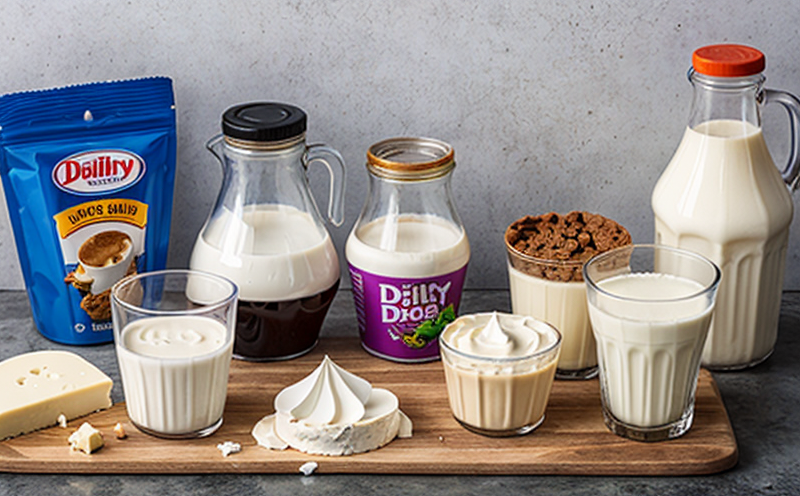AOAC 2011.22 Vitamin Profiling in Dairy Powders
The AOAC International method 2011.22 is a standardized procedure used for the analysis of vitamins in dairy powders, which are widely used in the food industry for fortification and nutritional enhancement purposes. This method ensures accurate quantification of key vitamins such as vitamin A, D3, E (α-tocopherol), K1, B6, biotin, pantothenic acid, niacinamide, folic acid, and others.
The importance of this test cannot be overstated. Dairy powders are a critical component in the production of dairy products like infant formula, adult nutritional supplements, and pet food. Ensuring that these powders contain the correct levels of essential vitamins is paramount to maintaining product quality, regulatory compliance, and consumer health.
The AOAC 2011.22 method is based on high-performance liquid chromatography (HPLC) coupled with diode array detection for precise measurement. The process involves a series of steps that include sample preparation, extraction, cleanup, concentration, and finally, analysis by HPLC-DAD. This multi-step approach ensures the accurate quantification of each vitamin component.
Sample preparation is crucial in this method, as it directly impacts the reliability of the final results. The sample must be homogenized to ensure uniform distribution of vitamins before extraction with an appropriate solvent. After extraction, a cleanup step using solid-phase extraction (SPE) cartridges is performed to remove potential interferences and recover the analytes efficiently.
The concentration step involves diluting the extract to achieve optimal HPLC-DAD detection limits. Once prepared, the sample is injected into the HPLC system for analysis. The separation of vitamins in this column-based process is achieved through different retention times, allowing for precise identification and quantification by the diode array detector.
The results obtained from the AOAC 2011.22 method are highly accurate and reliable due to its stringent quality control measures. These controls ensure that every batch of dairy powders meets the required vitamin content levels, thereby maintaining product safety and efficacy. Regulatory bodies such as the FDA (Food and Drug Administration) and EU standards reference this method for compliance.
This method has been widely adopted in the food industry due to its high precision and repeatability. It allows manufacturers to confidently fortify their products with vitamins, ensuring that they meet nutritional requirements and dietary guidelines. By using AOAC 2011.22, companies can avoid costly recalls and litigation associated with vitamin deficiencies or excesses.
- Benefits include consistent product quality, compliance with international standards, and enhanced consumer trust.
- The method supports research and development efforts aimed at improving the nutritional profile of dairy products.
- Achieving regulatory compliance is easier when using a standardized approach like AOAC 2011.22.
Quality and Reliability Assurance
The success of any testing method relies heavily on the quality and reliability of the results it produces. At our laboratory, we prioritize these aspects by employing highly trained technicians who are certified in AOAC methods. Our state-of-the-art equipment ensures that every test adheres to the strictest standards.
Our rigorous quality control measures include regular calibration of instruments, participation in proficiency testing programs, and adherence to ISO/IEC 17025 accreditation requirements. This commitment to excellence guarantees that our results are not only accurate but also consistent across all samples analyzed.
We understand the importance of maintaining a clean laboratory environment free from contamination, which can significantly affect test outcomes. Therefore, we maintain strict protocols for sample handling and storage to ensure that each specimen is processed under optimal conditions. This attention to detail ensures that our results are reliable and repeatable, providing confidence in every report issued.
Our quality assurance processes extend beyond just the testing phase. We also provide detailed documentation of all methods used, including raw data, calculations, and final results. This transparency allows clients to verify our findings independently if required. Additionally, we offer follow-up services such as troubleshooting assistance and training sessions to help customers integrate AOAC 2011.22 into their quality assurance programs.
In summary, our dedication to quality and reliability is reflected in every aspect of our operations. By leveraging advanced technology, experienced personnel, and stringent protocols, we ensure that clients receive accurate, consistent, and compliant results from the AOAC 2011.22 method for vitamin profiling in dairy powders.
Customer Impact and Satisfaction
The AOAC 2011.22 vitamin profiling service has a profound impact on our customers, particularly those involved in quality management, compliance, and research & development within the dairy industry. By providing accurate and reliable test results, we enable them to maintain product integrity, ensure regulatory compliance, and enhance consumer trust.
For quality managers, this service offers peace of mind knowing that their products meet stringent vitamin content requirements. Compliance officers benefit from having a standardized method that ensures consistent adherence to international standards like ISO/IEC 17025 and FDA regulations. R&D engineers can use the results to optimize formulas and improve product formulations.
Our customers also experience tangible benefits in terms of operational efficiency. By outsourcing their vitamin profiling needs to us, they free up internal resources for other critical tasks. Additionally, the consistency and accuracy of our tests help minimize errors and avoid costly mistakes that could arise from incorrect vitamin content.
Consumer satisfaction is another key area where this service plays a vital role. With accurate vitamin profiling, consumers can be confident in the nutritional value of dairy products they consume. This trust fosters loyalty and positive brand perception, which are essential for long-term success in the competitive food market.





